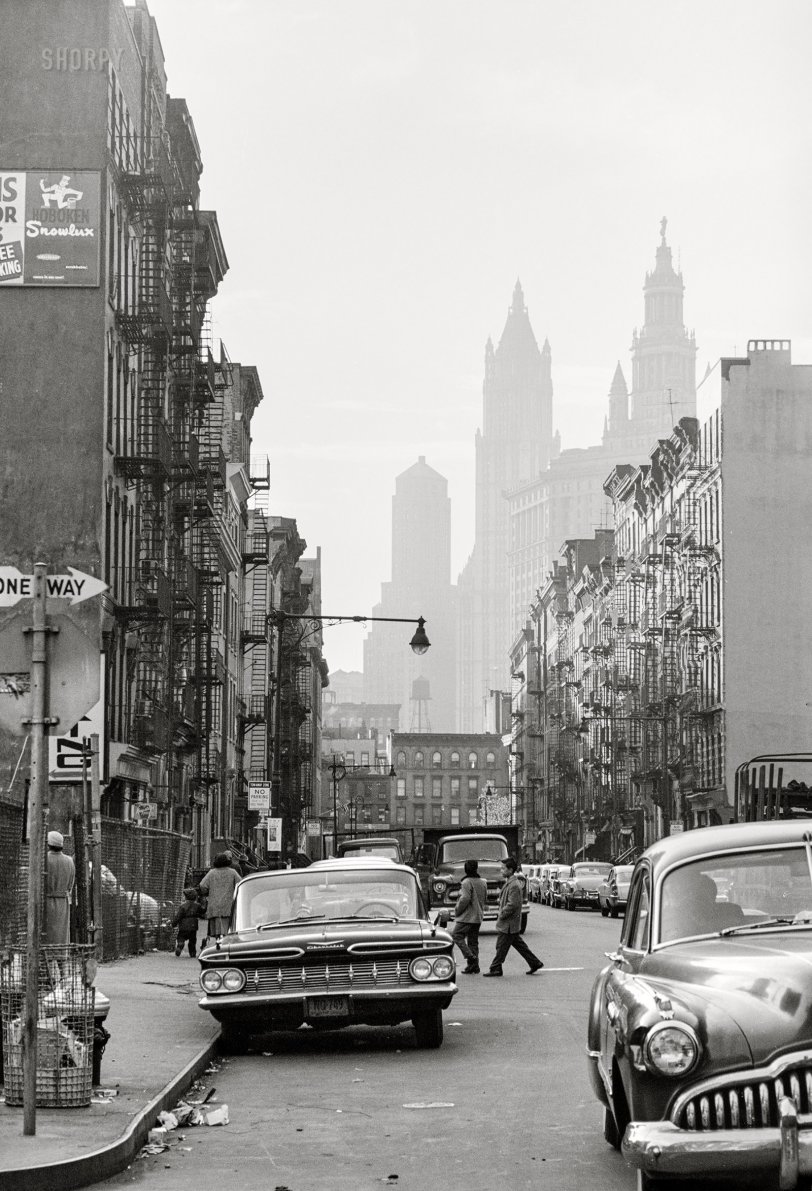


Framed or unframed, desk size to sofa size, printed by us in Arizona and Alabama since 2007. Explore now.
Shorpy is funded by you. Patreon contributors get an ad-free experience.
Learn more.

- Lofty addition
- In 1912
- Keenan Building
- Six years old
- Taken from the P.J. McArdle Roadway?
- It stood only 47 years
- Three track mind
- Incline to the right
- Reach for the sky, 1912 style
- No clean sweep
- Same Job Title, Same Face
- Sadly Lost
- Beautiful ...
- Where you get your kicks
- Aim High
- Pueblo Revival sisters
- Pueblo Neoclassicism
- Milk Man
- Regional dialect.
- Spielberg's inspiration
- Great Photo
- Loaf Story
- Do you still have the Rakes category?
- Could almost be a scene from the 1957 movie 'Hell Drivers'
- The Wages of Fear.
- Conspicuous by their absence
- Got Milk?
- All that aluminum
- No lefties
- Smoke 'em if you've got 'em
Print Emporium
East Side Story: 1959

November 4, 1959. "People and cars, Essex Street and Henry Street, Lower East Side, New York City." 35mm acetate negative by Marion Trikosko for the U.S. News & World Report assignment "Puerto Rican Story N.Y.C." USN&WR Collection, Library of Congress. View full size.
1949 Buick
The car heading toward us on the right seems to me to be a 1949 Buick Super Series 50.
Three days later, and half a continent away
I was born.
Unique look of Film
A challenge: create a similar looking image using a digital camera.
Standard Tread
The track (or tread to use the older term) width of American cars had been more-or-less standardized since the dawn of motordom; originally they had to fit the ruts left by Conestoga wagons and if you look at pictures from the London-to-Brighton run you can see the American cars axles are considerably wider than their bodies, while the European ones aren't.
By 1959 after several decades of "longer-lower-wider" you can see how the Chevy's body is overhanging it to the sides by some distance, and the elephant-on-roller-skates effect that has. That's why Pontiac's "Wide-Track" under the same basic bodyshell was such a sensation.
Answers 7-decade-old question
When we moved into my boyhood home in New Jersey in 1952, it was a nice home on a nice street. But the street name was "East Side Avenue." My mother, a native of the West Side, hated the street name, saying it reminded her of the "Lower East Side" of NYC. She got everyone on the street to sign a petition to have the street name changed, which it was. I never had a clear picture in mind of what Mom was talking about. Now, I do.
NO PARKING
Not much use here. Maybe no one can see them.
[You have to read the fine print! - Dave]

Farther down the street
If you look at the cornices of the buildings I'm pretty sure this is further along down Henry street nearer to 40 Henry. The corner to the left is now an unnamed street/alley bordering a parking lot.
[The building on the left is 58 Henry Street. - Dave]
1959 Chevy
The car parked on the curb, facing the photographer, is a 1959 Chevrolet - perhaps an Impala, but also possibly a Bel Air or a Biscayne. Hard to tell from the angle of the photo. My family had a 1959 Brookwood station wagon that would have looked essentially the same from the front. So aggressively ugly in that late 50's/early 60's style that it was almost a thing of beauty: wildly oversized horizontal wing-fins in the rear with huge horizontal teardrop taillights; massive chrome (anodized aluminum) grille up front, with additional horizontal styling touches above. Just an absolute monster. People like to hold up the infamous Edsel as the ugliest car of that period, but for me, the 1959 Chevy was every bit its equal.
[Biscaynes didn't have those fender ornaments. - Dave]
Perfect setting for a movie...
This photo beckons for some sort of giant insect creature to be walking amongst the skyscrapers, terrorizing the helpless humans.
Henry and Market Streets it is
Notcom is correct. First, Essex doesn't intersect Henry Street because Essex becomes Rutgers as it crosses E Broadway. Regardless, you would have to be on the west side of the Manhattan Bridge Roadway to take this picture; that would put you in the intersection with Market Street, looking west down Henry towards downtown Manhattan. On the right, the building with the blank wall is in the 1959 photo and the Google Street View. The six-bay building with arched windows on the top floor is where Henry Street dead ends into Oliver Street, and is still there. The depth of field in the 1959 photo is impressive.
[This is one of a group of photos documenting life in the largely Puerto Rican neighborhood that included Essex and Henry streets, with pictures taken along both. The caption, devised by a Library of Congress cataloger, shouldn't be taken to mean the streets intersect. - Dave]
Garbage can
Wow that open wire garbage can on the bottom left really takes me back, I remember them from when I was a kid.
East Side Story
This is more the real setting for "West Side Story." They used "West Side" instead of "East Side" because they preferred the sound of it.
Henry and ...
USN's credibility not withstanding, it would seem this was actually Henry and Market (farther east, at Essex, the view would be blocked by the Manhattan Bridge). Other than that the foreground scene is little different; beyond the Woolworth Building, though, there've been some changes over the years.
























On Shorpy:
Today’s Top 5